These Easter Macarons are so fun for Easter! Shaped and decorated like Easter Eggs, these French macarons are sure to be the hit of your holiday! Getting ready for Easter? Check out my Coconut Macaroons and Cream Cheese Mints.
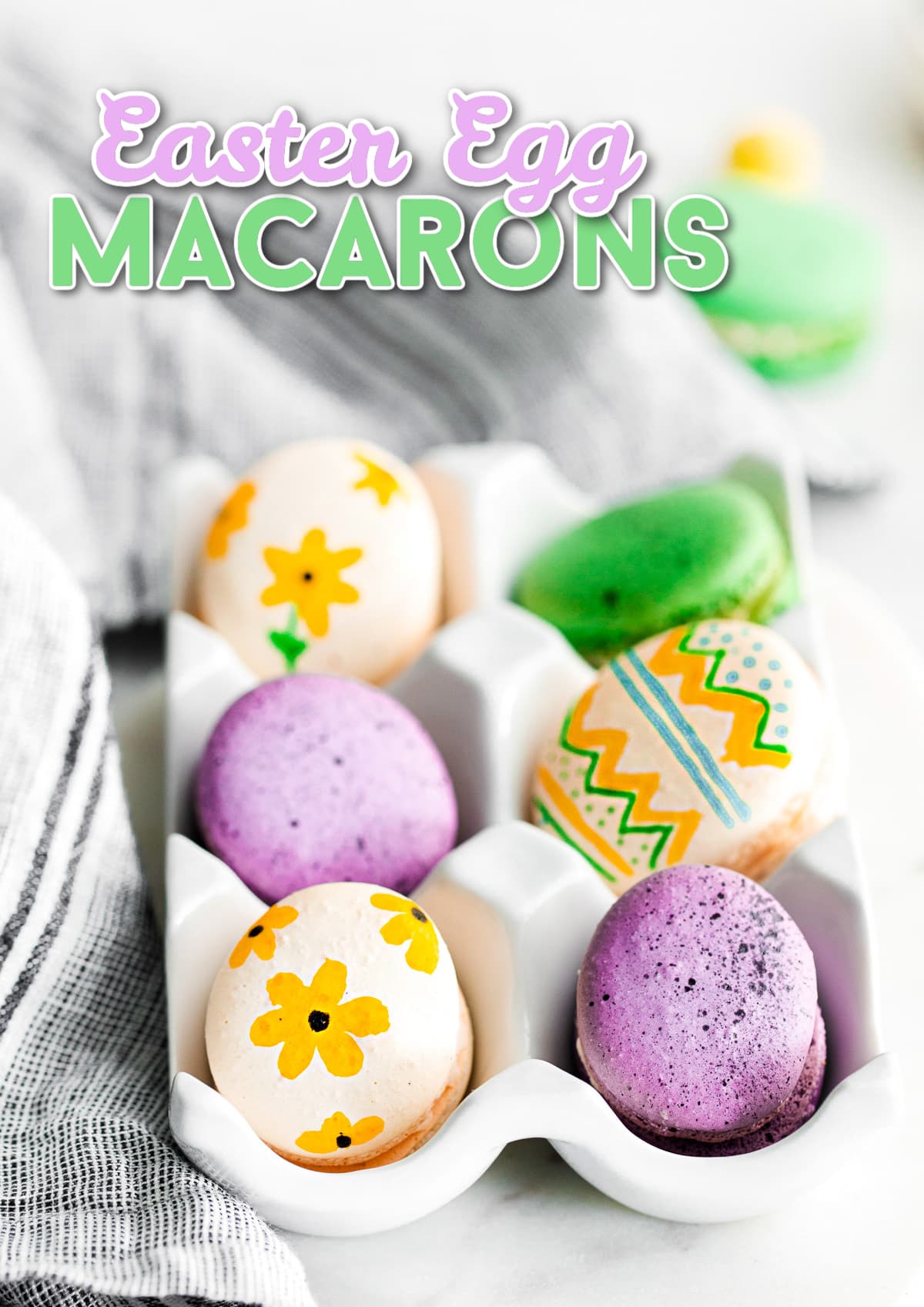
Just last month I shared this delicious Irish Cream Macarons recipe which was perfect for St. Patrick’s Day. Today, I’m sharing these Easter Egg Macarons which are so fun for Easter!
These delicious macarons are shaped like eggs and then decorated like Easter Eggs for a tasty Easter dessert that’s almost too pretty to eat.
I used two different techniques to decorate the macarons:
- food coloring pens – you can find these in craft stores and other big retail stores or you can buy them online. They are perfect for drawing on these macarons and will allow you to easily create a beautiful variety of decorated Easter macarons. Here is a great set of food grade coloring pens.
- speckled egg – this is the same technique that I used in my Easter Cake that I recently posted. You essentially splatter diluted gel food coloring onto the top of the macarons using a pastry brush. You must be very careful not to get the food color on any surfaces, clothes, etc. It stains! Make sure to protect all surfaces!
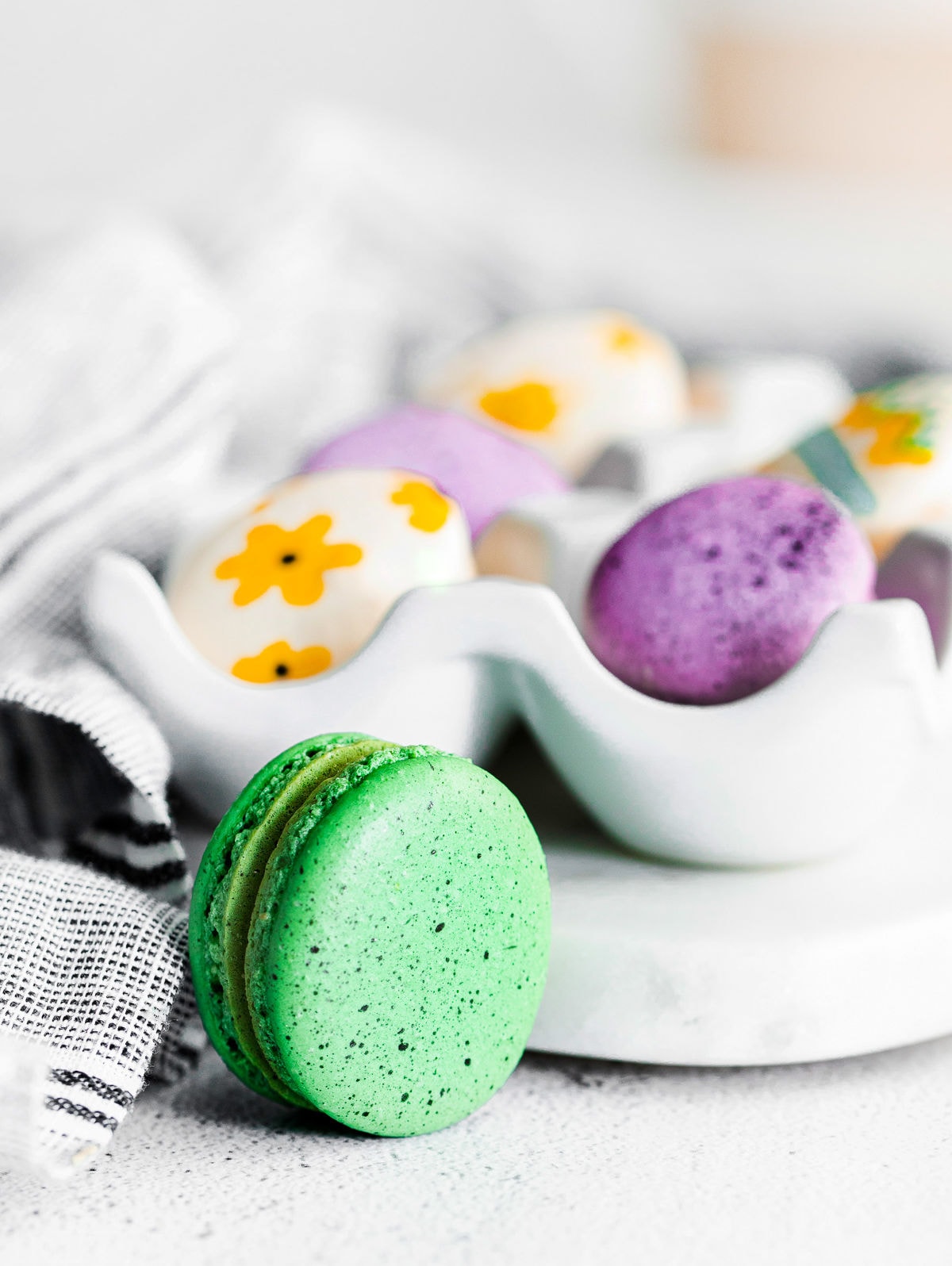
Easter Macarons
Besides being very pretty, these Easter Egg Macarons are also delicate and delicious! The crunchy shell and creamy middle of macarons require a bit of technique to master, but with my easy to follow steps, you’ll have it down in no time.
What Are Macarons?
Macarons are traditional French (some say Italian!) cookies that have been around for ages – since the 19th century, at least.
The delicate cookies themselves are usually made with egg whites, granulated sugar, powdered sugar, and almond flour. The filling in between the two crunchy, yet chewy cookies differs for each recipe. Today we’re making a simple vanilla buttercream.
Macaron Ingredients
The ingredients list to these French Macarons is short and sweet. You can find the full, printable recipe at the bottom of this post. Let’s take a look at what you’ll need:
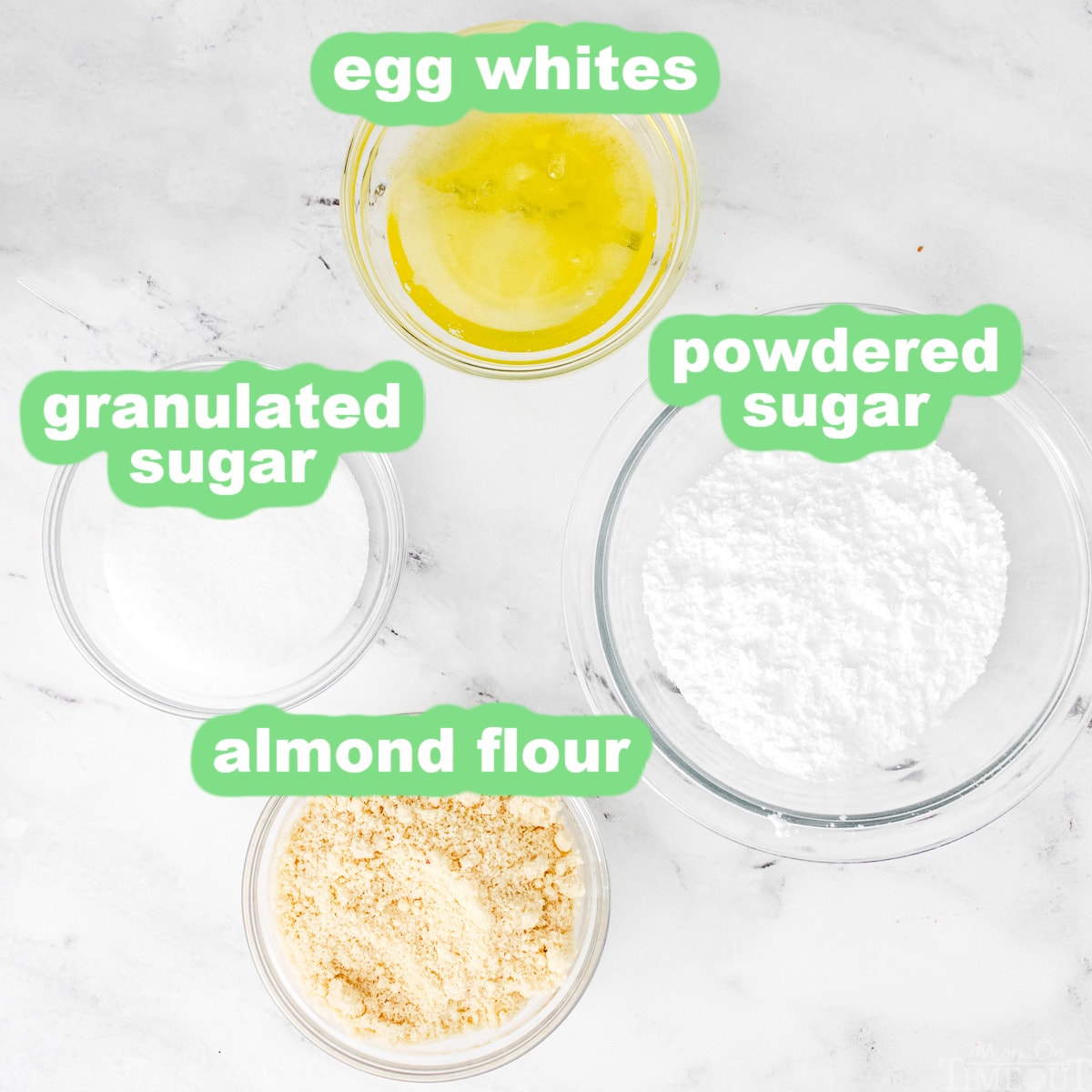
For the shell, you’ll need:
- egg whites – This is truly the key ingredient for macaron shells. I recommend letting the egg whites adjust to room temperature before using, as they’ll be easier to whip that way!
- granulated sugar – This is needed to help the egg whites stretch into the perfect meringue.
- powdered sugar – This sugar helps the shell stay light, fluffy, and sweet.
- almond flour – Blanched almond flour helps to give the macaron cookies the desired unique texture and flavor.
To color the Easter Egg macarons, I divided the batter into thirds. One third I colored purplish pink (one drop of purple, one drop of pink), one third I colored green (one drop of royal blue and one drop of yellow) and the remaining third I kept white. You can, of course color these macarons with any colors you wish – just make sure to use gel food coloring!
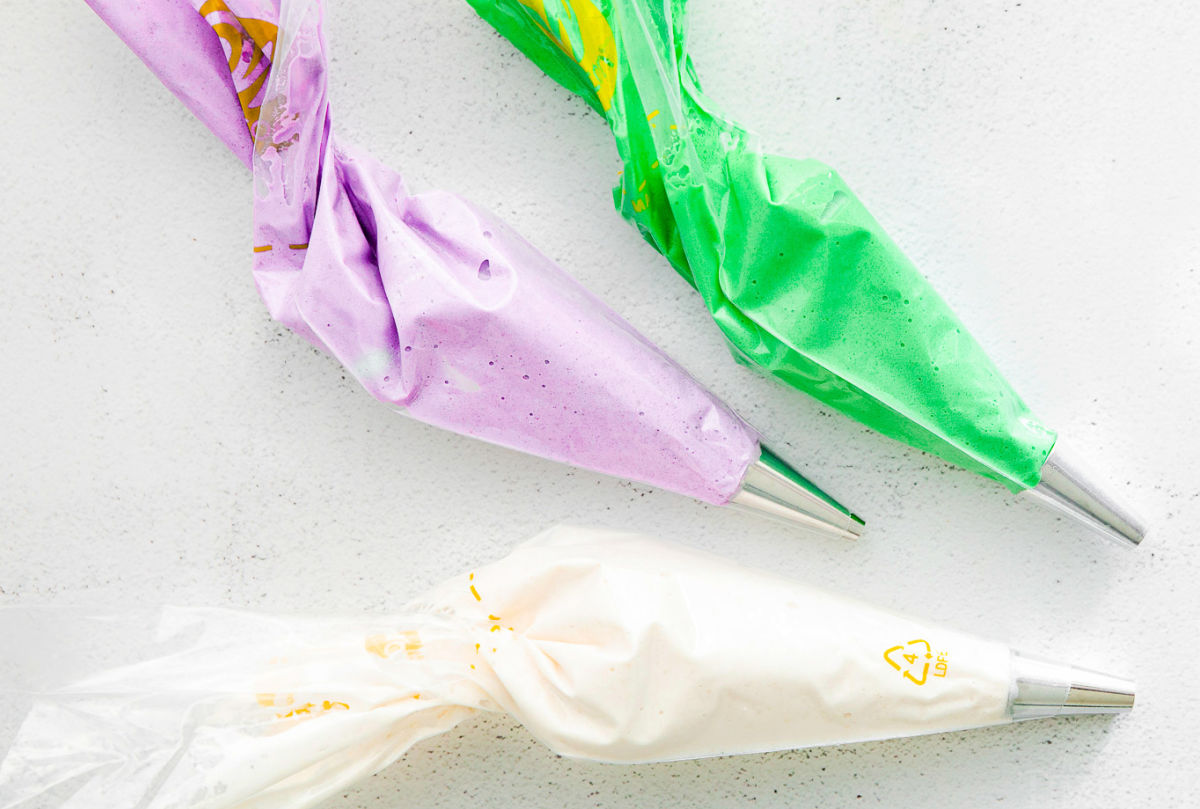
For the buttercream filling:
- butter – the base of this buttercream filling
- powdered sugar – for a delicate touch of sweetness
- vanilla extract – to flavor the buttercream
- heavy cream or milk – to thin the buttercream if needed
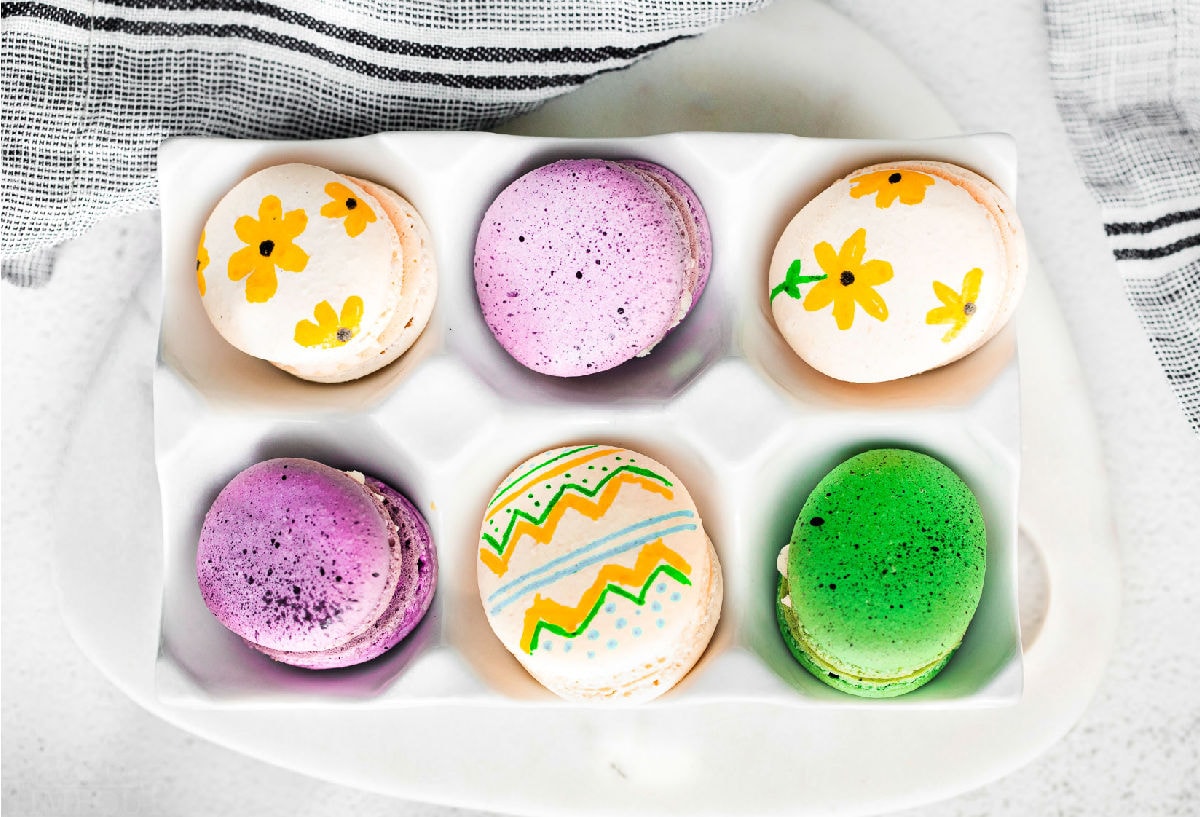
How To Make the Perfect French Macarons
If this is your first time (or your sixth time!) making macarons, it can really be intimidating. You can do it! Just follow these simple steps one at a time, and you’ll have a delicious, gorgeous batch of French Macarons.
First, start off by making the batter for the shells.
- Fill a small saucepan halfway with water and set it over medium heat. Then, place a heatproof bowl over the pan, making sure it doesn’t touch the water.
- Add the egg whites and sugar to the bowl, whisking constantly until the sugar has dissolved, about 2 minutes.
- Transfer the egg white mixture to the bowl of a stand mixer fitted with the whisk attachment. Beat on medium high until the mixture forms stiff peaks, about 5 minutes.
- Sift the powdered sugar and almond flour into the egg whites.
- Gently fold the dry ingredients into the egg whites, making sure not to deflate the egg whites. Make sure to scrape the sides of the bowl as you fold.
- Once all of the dry ingredients have been incorporated into the egg whites, add the gel food coloring, if using. (see notes in recipe card)
- Continue folding the meringue but this time begin gently smushing the batter against the sides of the bowl in a circular motion, then scrape down the sides of the bowl and fold it all back together.
- Repeat this deflating process until the batter flows smoothly off the spatula.
You can test the batter’s consistency by slowly drawing a figure 8 with the batter. If the you can make an “8” with the batter flowing off the spatula in a constant stream, it’s ready to pipe! If it breaks or falls in clumps, smush and fold a few more times until the desired consistency is achieved.
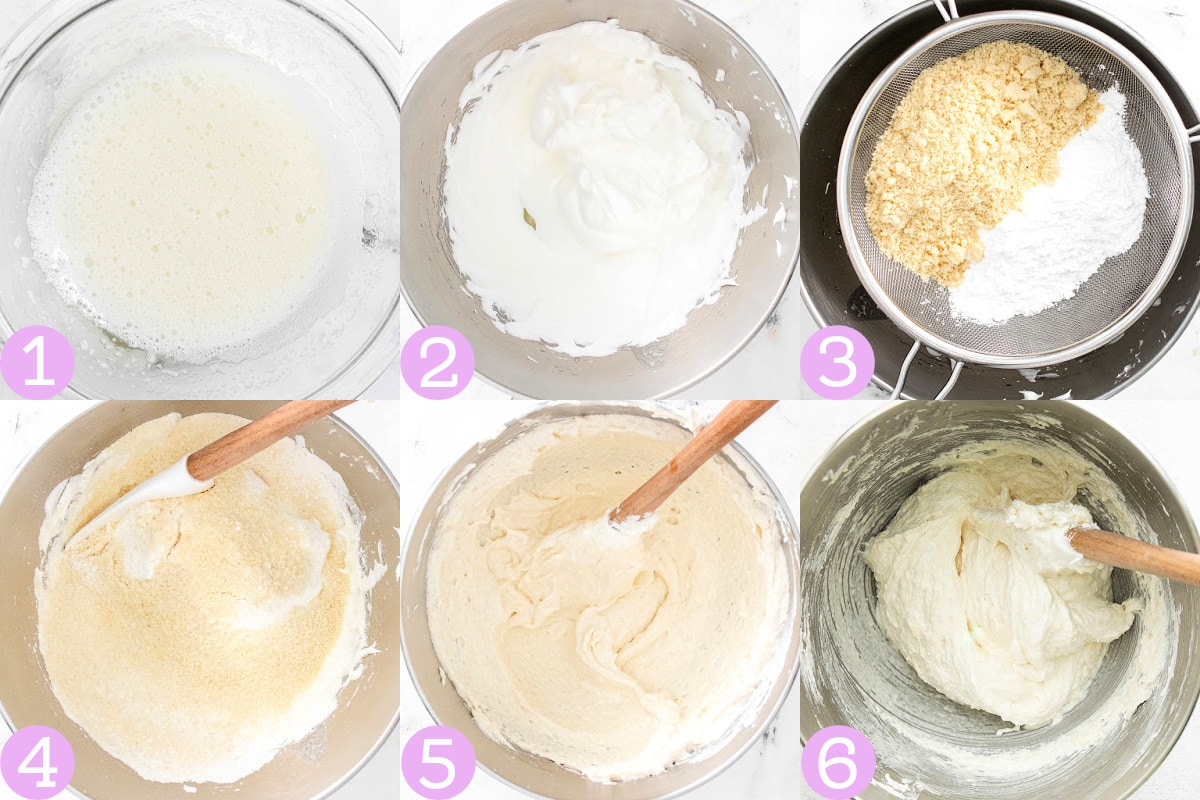
Pipe and Bake Macarons
- Line large baking sheets with silicon baking mats or parchment paper.
- Transfer the mixture to a piping bag fitted with an open round tip. A #12 piping tip or #10 tip works perfectly.
- Pipe 1” circles or egg shapes about 2” apart holding the piping bag perpendicular to the surface. Using a silicon macaron mat will help with this step.
- Once you’ve finished piping one tray, tap the tray firmly on the counter or drop straight down onto the counter five or six times to release any air bubbles. Repeat for the second tray.
- Let the shells rest for about 30 minutes or until the tops feel dry to the touch. This can take up to an hour.
- Preheat the oven to 325°F (you can check the oven temperature using an oven thermometer – this is especially helpful if you think your oven runs a little hot).
- Bake the shells one baking sheet at a time for 12 to 15 minutes, rotating the baking sheet halfway through if necessary. The shells are done when they don’t move or jiggle about when the baking sheets are moved.
- Allow the macarons to cool before removing them from the tray.
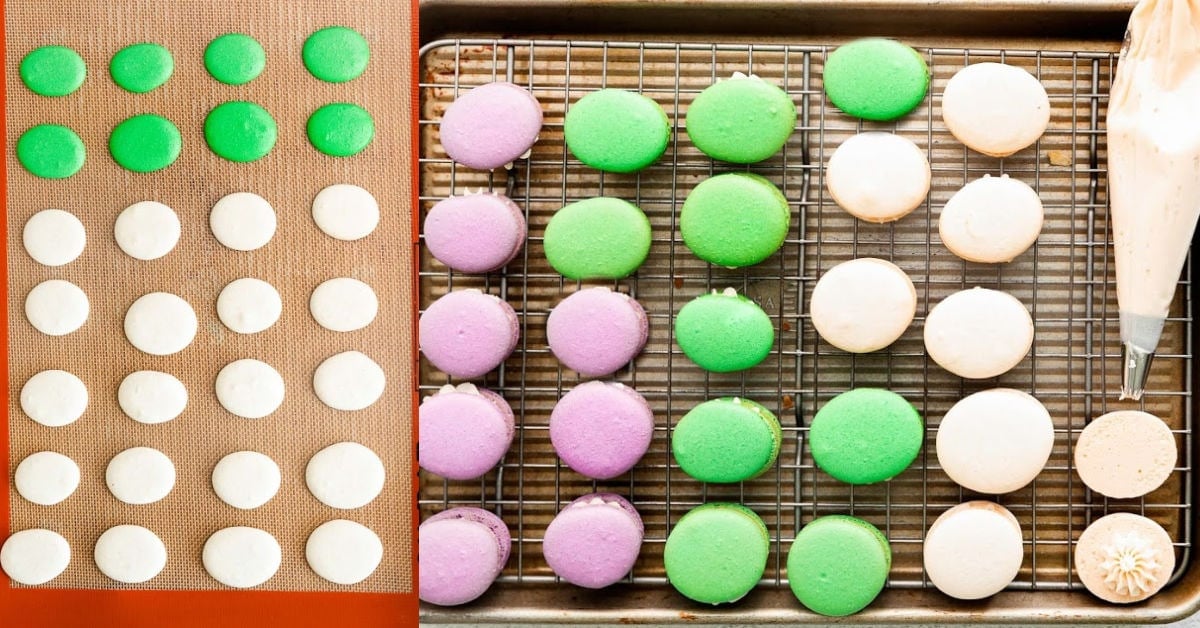
Make the buttercream filling
- In the bowl of a stand mixer, beat butter until it has lightened in color, about 2 minutes.
- Reduce the speed to low and slowly add the powdered sugar. Add the vanilla extract and mix until combined. If the buttercream seems too thick, beat in a tablespoon of heavy cream or milk.
- Transfer the mixture to a piping bag fitting with a piping tip of your choosing and set aside.
Assemble and age!
- Place the macarons in similar sized pairs.
- Pipe a small dollop of filling on one macaron and place another on top.
- Press gently, just until the filling reaches the edges.
- To decorate the macarons, use food coloring pens or white chocolate to draw on the macarons. To make the speckled egg macarons, combine 1 teaspoon of water with a few drops of black gel food coloring and use a pastry brush to splatter the food dye on the macarons. Be very careful not to get the food color on any surfaces, clothes, etc. It stains! Make sure to protect all surfaces!
- Place the macarons in an airtight container in the fridge to age overnight.
- Bring to room temperature before serving.
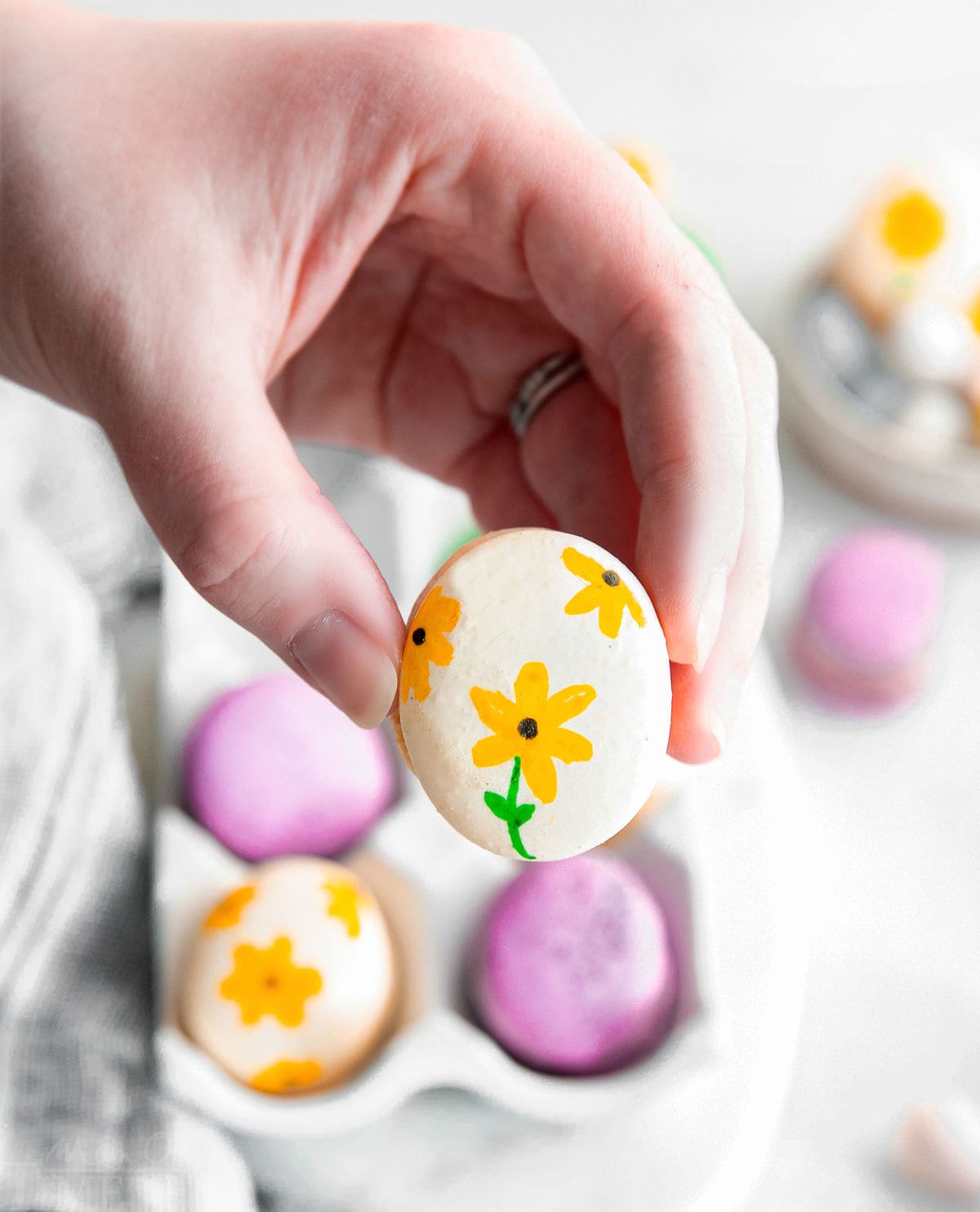
FAQs
How do I store macarons?
These homemade French macarons will stay fresh in the fridge for up to 4 days. Just make sure to keep them in an airtight container to preserve both their texture and flavor!
Why are my macarons lopsided?
The best way to make perfectly shaped macarons every time is to hold the piping bag perpendicular to the tray while you’re piping. If you hold the piping bag at an angle, that might result in lopsided macarons. They’ll still be tasty, but they won’t be as picture perfect as you want them to be.
Why do I need to age the macarons overnight?
This step is optional, but I highly recommend it! Aging the macarons overnight helps to soften the shell, thereby creating the perfectly crisp, yet chewy macaron texture that we all know and love.
Trish’s Tips for Perfect Macarons
Beat until egg whites have stiff peaks.
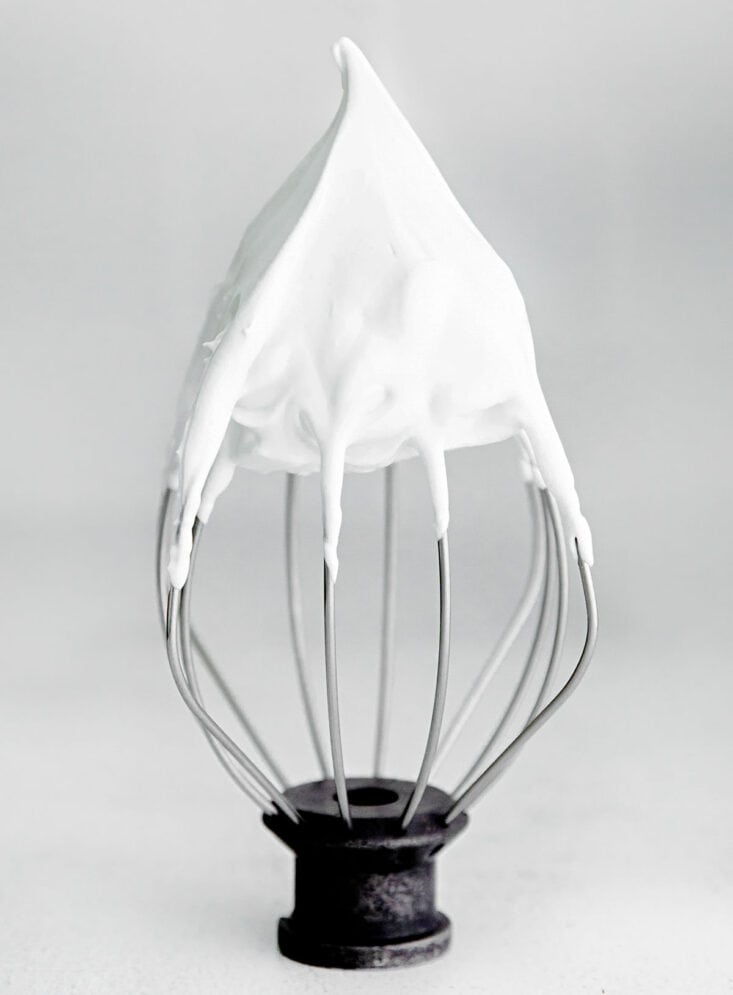
It’s super important to beat the egg whites until stiff peaks form. Stiff peaks means that the “peaks” don’t fall over when held upright. This is what a stiff peak looks like, nice and tall without the tip falling to one side.
Use a silicone baking mat. Silicone baking mats are a really beneficial when it comes to making macarons. Beginners and advanced macaron makers can benefit from these silicone macaron mats that have circles to help you keep the macarons the same size.
Another trick is to place one of these mats beneath a piece of parchment so that you can see the outline of the circles through the parchment paper. Parchment paper is actually used by advanced macaron bakers because of it’s super slick surface.
Let macarons sit out for an hour before enjoying. The texture and flavor or a macarons improves when enjoyed after sitting out for about an hour after removing the cookies from the refrigerator.
Match up shell sizes before assembly.
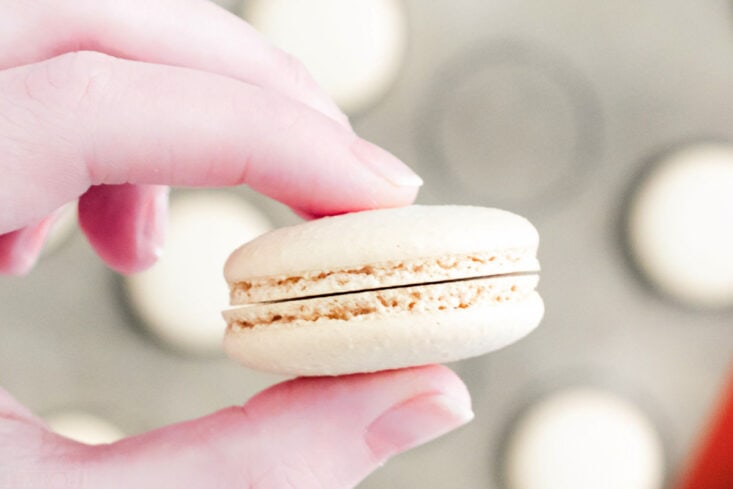
Take a minute to match up the shells by size before assembling the macarons. This really gives your macarons a more professional appearance and ensures that none of the filling oozes out.
Variations To Try
- Have fun and decorate your homemade macarons with drizzled melted chocolate and sprinkles.
- Try using a different flavored buttercream for the filling. You can use any flavor extract you like.
- You can also color the butter cream for a fun contrast in color. Just be sure to use gel food coloring.
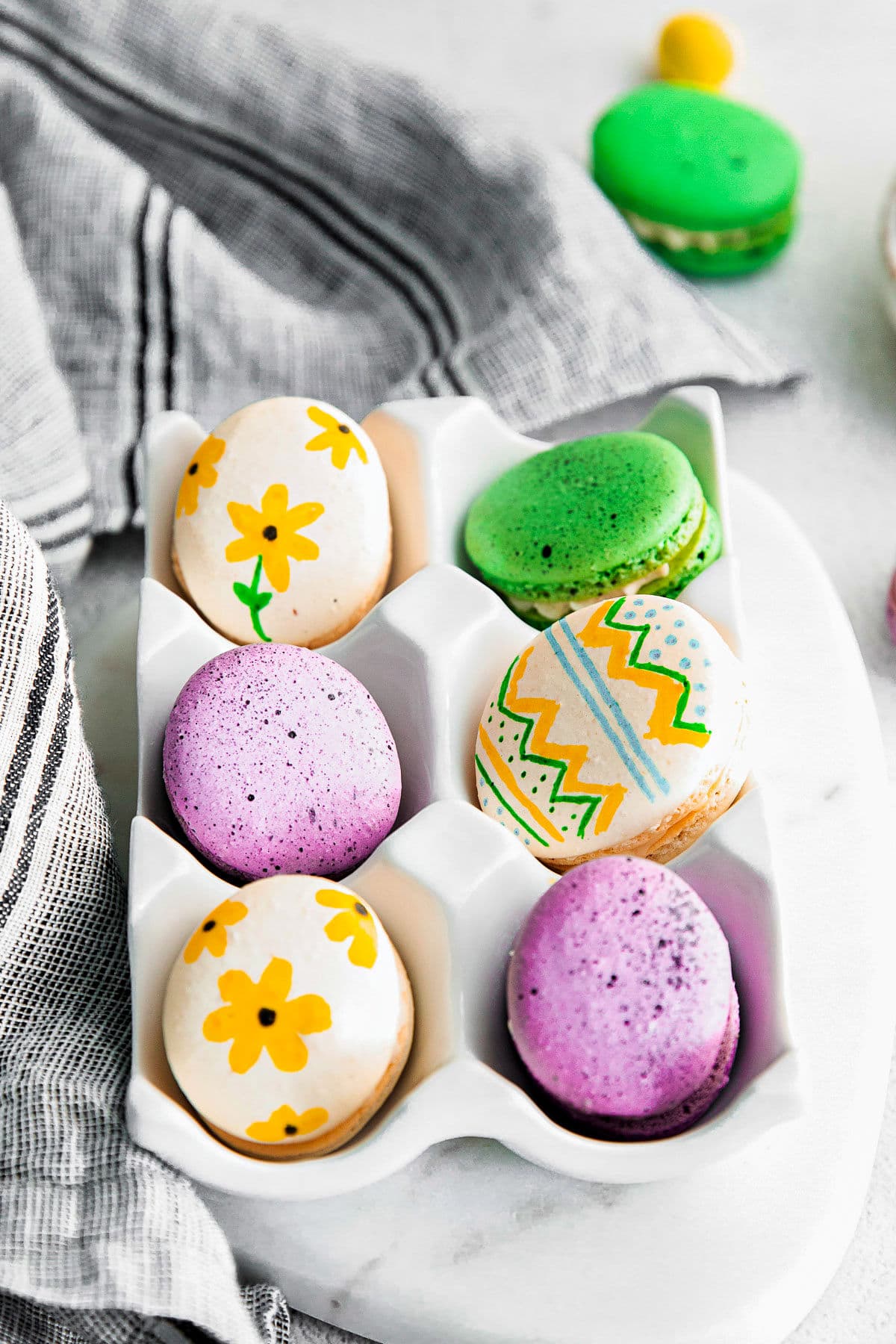
More Easter Recipes
- Three Minute Easter Fluff
- Easter Cookies
- To Die For Carrot Cake
- Coconut Cream Pie
- Watergate Salad
- Speckled Egg Easter Cake
How To Make Easter Macarons
Easter Egg French Macarons
Ingredients
For the Shell
- 90 grams egg whites
- 90 grams granulated sugar
- 95 grams powdered sugar
- 95 grams almond flour finely ground
For the Filling
- 8 tablespoons salted butter softened
- 2 ¼ cups powdered sugar
- 1 teaspoon vanilla extract
Instructions
Prepare the Shells
- Line two half sheet baking sheets with silicone baking mats or parchment paper. (If you wish to use parchment, make sure the parchment lays perfectly flat so you don’t end up with lopsided macarons. You can tape the parchment temporarily to help keep it secure while piping and then remove the tape before baking.)
- Fill a small saucepan halfway with water and set it over medium heat. Then, place a heatproof bowl over the pan, making sure it doesn’t touch the water.
- Add the egg whites and granulated sugar to the bowl and whisk constantly until the sugar has completely dissolved. This will take about 2 to 3 minutes. (Test to make sure the sugar is dissolved by rubbing the mixture between your fingers. If it’s smooth, it’s ready to go. If the mixture feels grainy or sandy, keep whisking for another minute or so and then try again.)
- Transfer the egg white mixture to a clean, dry bowl of a stand mixer fitted with the whisk attachment. Beat on medium high until the mixture forms stiff peaks, about 5 minutes.
- Sift the powdered sugar and almond flour into the egg whites.
- Gently fold the mixture together, making sure to scrape down the sides of the bowl as you fold. Take your time and be careful that you are not deflating the egg whites just yet.
- Gently fold the dry ingredients into the egg whites, making sure not to deflate the egg whites. Make sure to scrape the sides of the bowl as you fold.
- Once all of the dry ingredients have been incorporated into the egg whites, add the gel food coloring, if using. (see notes below) Continue folding the meringue but this time begin gently smushing the batter against the sides of the bowl in a circular motion, then scrape down the sides of the bowl and fold it all back together. Repeat this deflating process until the batter flows smoothly off the spatula. (On average this takes about 5 smush and folds but will be dependent on how much you deflate the egg whites each time.)
- You can test the batter’s consistency by slowly drawing a figure 8 with the batter. If the you can make an “8” with the batter flowing off the spatula in a constant stream, it’s ready! If it breaks or falls in clumps, smush and fold a few more times until the desired consistency is achieved.
- When the meringue flows smoothly, transfer the mixture to a piping bag fitted with an open round tip. A #12 piping tip or #10 tip works perfectly.
- Pipe 1” circles or egg shapes about 2” apart holding the piping bag perpendicular to the surface. Using a silicon macaron mat will help with this step. Once you’ve finished piping one tray, tap the tray firmly on the counter or drop straight down onto the counter five or six times to release any air bubbles. Repeat for the second tray. The shells will flatten slightly.
- Let the shells rest for about 30 minutes or until the tops feel dry to the touch (this is called developing a skin). This can take up to an hour.
- While the shells rest, preheat your oven to 325°F (you can check the oven temperature using an oven thermometer – this is especially helpful if you think your oven runs a little hot)..
- Bake the shells one baking sheet at a time for 12 to 15 minutes, rotating the baking sheet halfway through if necessary. The shells are done when they don’t move or jiggle about when the baking sheets are moved. Allow the macarons to cool before removing them from the tray.
Prepare the Vanilla Buttercream Filling
- In the bowl of a stand mixer, beat butter until it has lightened in color, about 2 minutes.
- Reduce the speed to low and slowly add the powdered sugar. Add the vanilla extract and mix until combined. If the buttercream seems too thick, beat in a tablespoon of heavy cream or milk.
- Transfer the mixture to a piping bag fitting with a piping tip of your choosing and set aside.
Assemble and Age
- Place the macarons in similar sized pairs. Pipe a small dollop of filling on one macaron and place another on top. Press gently, just until the filling reaches the edges.
- To decorate the macarons, use food markers or white chocolate to draw on the macarons. To make the speckled egg macarons, combine 1 teaspoon of water with a few drops of black gel food coloring and use a pastry brush to splatter the food dye on the macarons. Be very careful not to get the food color on any surfaces, clothes, etc. It stains! Make sure to protect all surfaces!Place the macarons in an airtight container in the fridge to age overnight. Bring to room temperature before serving.
- Place the macarons in an airtight container in the refrigerator to age overnight. Bring to room temperature before serving. Store in the fridge for up to four days.
Notes
- Hold piping bag perpendicular to the baking sheet while piping. Holding it at an angle can result in lopsided macarons.
- Aging the macarons overnight is optional but helps to soften the shell and create that perfect crisp and chewy macaron texture that macarons are known for.
- To color the Easter Egg macarons, I divided the batter into thirds. One third I colored purplish pink (one drop of purple, one drop of pink), one third I colored green (one drop of royal blue and one drop of yellow) and the remaining third I kept white. You can, of course color these macarons with any colors you wish – just make sure to use gel food coloring!






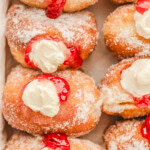

Leave a Reply